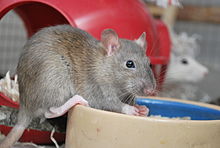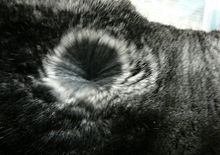agouti


As agouti (also tabby or agouti ) refers to the classic coat pattern of domestic cats , but also coat patterns of other species such as degus , rabbits , rats , mice or guinea pigs . The associated gene locus is named after the agoutis , South American rodents, which show a typical expression of the wild color.
How the gene works
The agoutilocus (a) is the gene for the agouti signaling peptide (ASIP), whose function is simultaneously influenced by the melanocortin receptor 1 (MC1R), which is encoded by the extension locus (E).
The pigment cells are influenced by their localization and the surrounding cell environment via the agouti gene , and the distribution of black and yellow pigments is controlled. This creates both the light and dark banding of individual hairs of the wild coloring of many animal species as well as the distribution over the whole body, such as in German shepherds .
By mutating this locus, the yellow band of the single hair is either lost (non-agouti) or expanded (yellow or agouti). The ventral side of the body is preferred for phaeomelanin formation. Alleles of this locus are abbreviated with A, the dominant allele A y coding for the yellow hair color and the recessive allele a for the black hair color.
This means that through mutations of the agoutilocus, the black areas in the fur pattern can be enlarged ( nigrism ) until, in extreme cases, the entire body is black ( scotasmus ); so “ melanism ” arises to varying degrees. Melanism caused by the agoutilocus is inherited recessively.
Conversely, dark skin markings can be reduced in size until, in extreme cases, they disappear completely and the animal is red or yellow all over its body. Some mutations of this locus lead to obesity and yellow fur, partly connected with diabetes mellitus .
dog
In domestic dogs , the agouti locus is on chromosome CFA24.
There are four alleles. The allele fawn / sable (A y ) leads to sand-colored , yellow or red-brown animals, which sometimes have a dark face mask, a saddle pattern made of through -colored black hair as in the collie or individual dark hairs in their fur. The allele a w (wolf-sable) is the allele of the wild-colored dog with lots of light and dark banded hair. It is the predominant allele determining coat color in most subspecies of the wolf .
Punnett's square : mating of an at-carrier with a homozygous aw wolf-sable: the allele a w is dominant over a t .
The allele a t (black-and-tan or brown-and-tan) leads to a black or dark brown pigmentation of large areas of the fur, especially on the back with lighter markings on the legs and face or to a tan-colored dog with black saddle markings. The recessive allele a for black pigmentation of the entire fur occurs, for example, in the German Shepherd Dog as well as in Groenendael , Schipperke , Shetland Sheepdog and Newfoundland dog . There is another gene that leads to black fur, which is encoded by the K locus. Unlike the recessive a, the gene on the K locus is dominant. On the A locus, the order in the dominance hierarchy is : A y > a w > a t > a.
mouse
In the house mouse breed, there are various alleles that produce color variants that range from a dominant light color to a recessive black color.
A certain mutation of this gene location is called Viable Yellow . In homozygous animals, this mutation is associated with a “yellow” color, fatty degeneration, an increased tendency to cancer and increased insulin secretion.
Hybrids that have one allele for black and one for viable yellow from the agouti gene can look just as "yellow" as a mouse in which both alleles of the agouti locus have the viable yellow variant. But they can also look like the parent animal, in which both alleles code for the color of black mice; there are also black and yellow spotted mice. By imprinting - ie the switching off of an allele of the agouti gene in each cell by the DNA is methylated before these genes - that of the gene in each hair is quasi visible alleles of the active and on the basis of the resulting color is determined.
If you feed mice with food that makes it easier for the mice to re-methylate one of the alleles so that it can no longer become active, the non-mutated gene will be more active than in mice that have not received this food. It also plays a role whether the gene in the mother was more active or inactivated; Mice can not only pass on their genes, but also their activation status. In addition, the allele from the mother is more active than that from the father.
Cats
In cats, Agouti (A) is the wild type and dominant. The agouti gene causes the tabby pattern to be formed.
The Nonagouti (a) mutation is recessive. A cat with the genotype aa is monochrome unless it is red or cream. The nonagouti allele means that the hair is not banded, but colored through in one color. Only in young animals does the tabby pattern still shine through as a ghost drawing .
horse
In horses, the dominant agouti gene A corresponds to the coat color of the brown (brown with a black mane and black tail), while the recessive form (a) means that the black spreads over the whole body and a black horse develops.
Individual evidence
- ↑ a b Krista Siebel: Analysis of genetic variants of loci for the coat color and their relationships to the color phenotype and to quantitative performance characteristics in pigs. Inaugural Dissertation for the Degree of Doctor of Veterinary Medicine; Institute for Animal Science at the Humboldt University in Berlin, July 2001.
- ↑ a b S. M. Schmutz, TG Berryere: Genes affecting coat color and pattern in domestic dogs: a review. In: Anim Genet. 2007 Dec; 38 (6), PMID 18052939 , pp. 539-549.
- ↑ Alaska Fur ID: Banding in wolf hair
- ↑ Animal Labs: Dog Coat Color - Genetic Testing
- ↑ Sheila Schmutz: Dog Coat Color Genetics. Agouti. Status: October 15, 2005.
- ↑ JA Kerns, EJ Cargill, LA Clark, SI Candille, TG Berryere, M. Olivier, G. Lust, RJ Todhunter, SM Schmutz, KE Murphy, GS Barsh: Linkage and segregation analysis of black and brindle coat color in domestic dogs. In: Genetics. 2007 Jul; 176 (3), PMID 17483404 , pp. 1679-1689.
- ↑ a b c George L. Wolff, Ralph L. Kodell, Stephen R. Moore, Craig A. Cooney: Maternal epigenetics and methyl supplements affect agouti gene expression in Avy / a mice. (on-line)
literature
- SM Schmutz, TG Berryere, NM Ellinwood, JA Kerns, GS Barsh: MC1R studies in dogs with melanistic mask or brindle patterns. In: J Hered. 2003 Jan-Feb; 94 (1), PMID 12692165 , pp. 69-73.
- JA Kerns, JM Newton, TG Berryere, EM Rubin, JF Cheng, SM Schmutz, GS Barsh: Characterization of the dog Agouti gene and a nonagoutimutation in German Shepherd Dogs. In: Mamm Genome. 2004 Oct; 15 (10), PMID 15520882 , pp. 798-808.
- JA Kerns, M. Olivier, G. Lust, GS Barsh: Exclusion of melanocortin-1 receptor (mc1r) and agouti as candidates for dominant black in dogs. In: J Hered. 2003 Jan-Feb; 94 (1), PMID 12692166 , pp. 75-79.
- TG Berryere, JA Kerns, GS Barsh, SM Schmutz: Association of an Agouti allele with fawn or sable coat color in domestic dogs. In: Mamm Genome. 2005 Apr; 16 (4), PMID 15965787 , pp. 262-272.
- JM Newton, AL Wilkie, L. He, SA Jordan, DL Metallinos, NG Holmes, IJ Jackson, GS Barsh: Melanocortin 1 receptor variation in the domestic dog. In: Mamm Genome. 2000 Jan; 11 (1), PMID 10602988 , pp. 24-30.




